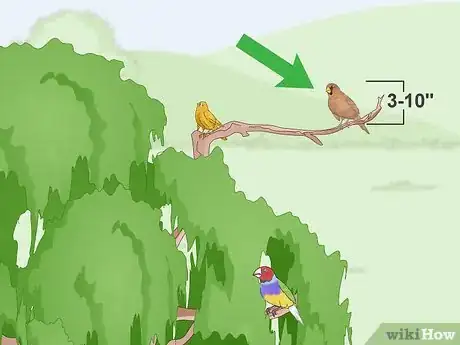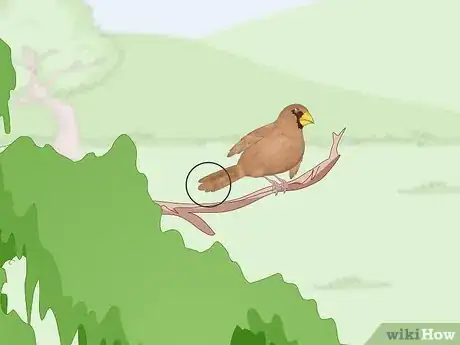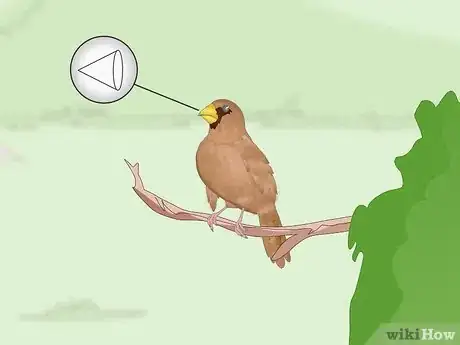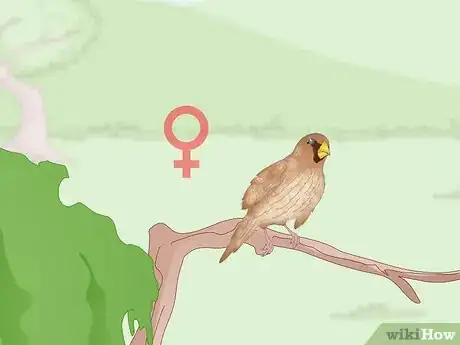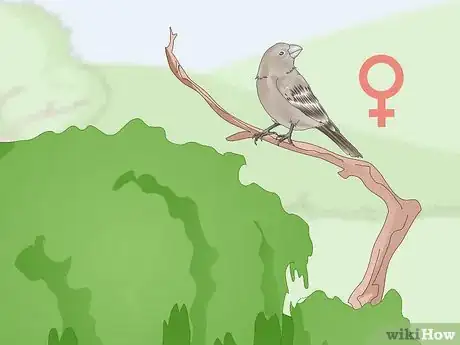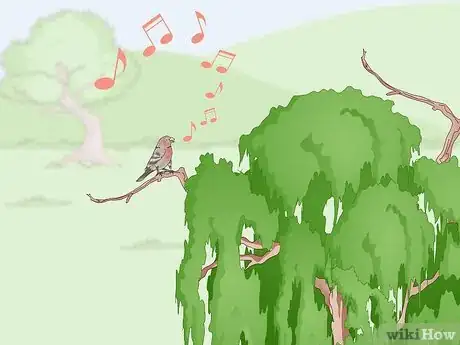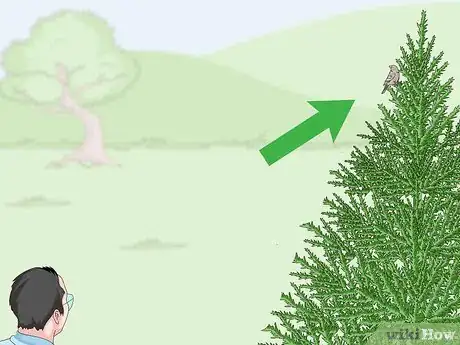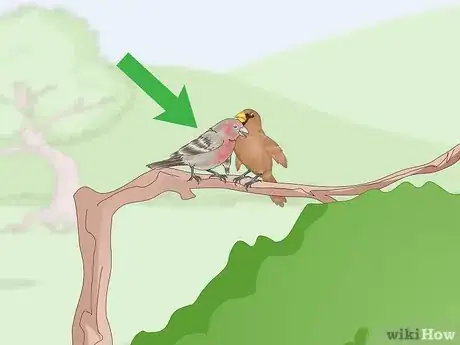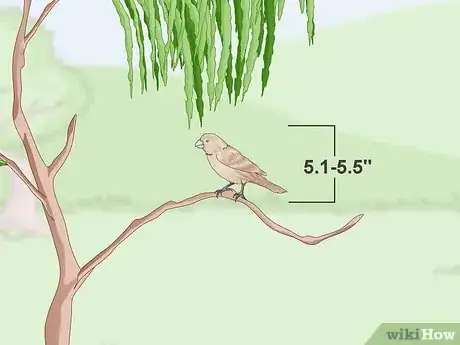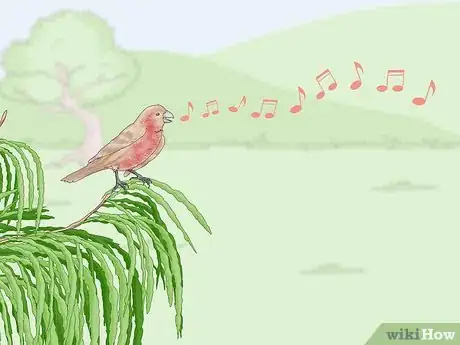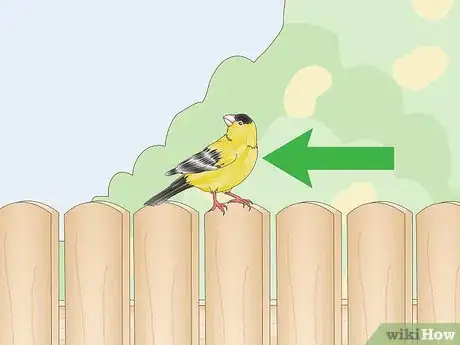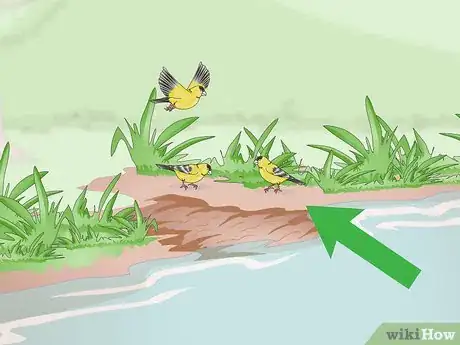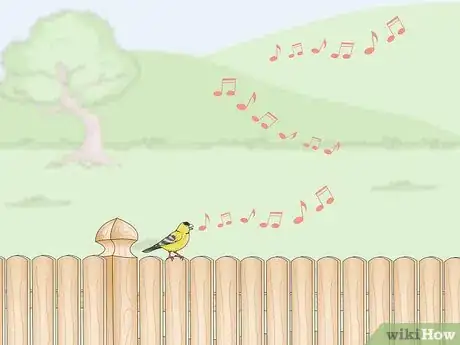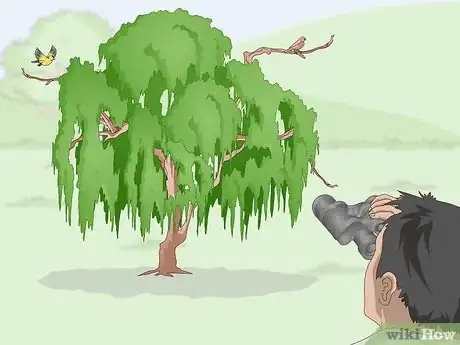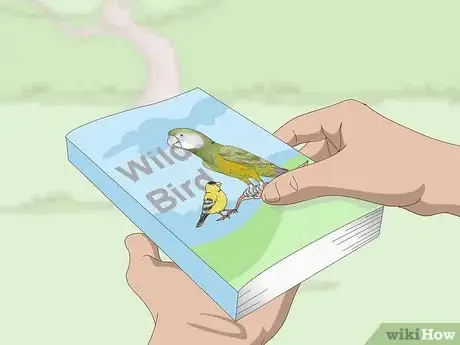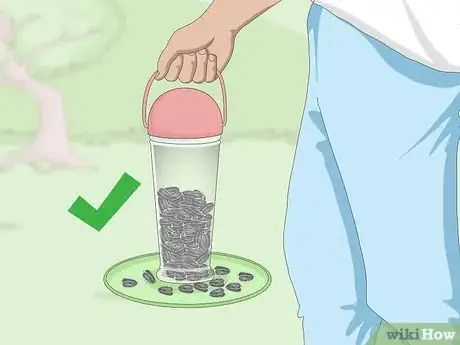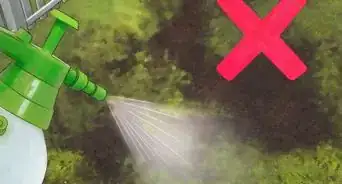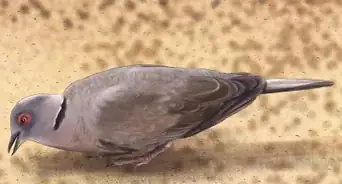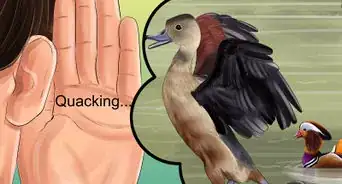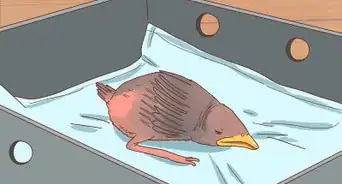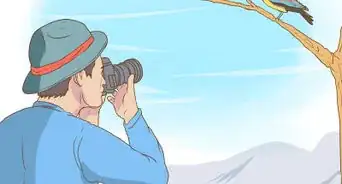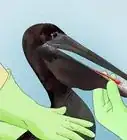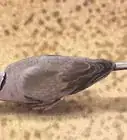This article was co-authored by Roger J. Lederer, PhD. Dr. Roger Lederer is an Ornithologist and the founder of Ornithology.com, an informative website about wild birds. Dr. Lederer has spent over 40 years teaching, studying, and writing about birds. He has traveled to over 100 countries to study birds. Dr. Lederer is an Emeritus Professor of Biological Sciences at California State University, Chico, and has been a Department Chair of Biological Sciences and Dean of the College of Natural Sciences. He has written more than 30 research papers and 10 books on birds and a textbook entitled “Ecology and Field Biology.” Dr. Lederer has consulted the BBC, National Geographic, National Public Radio, ABC News, the Guinness Book of World Records, and numerous other organizations and publications.
There are 25 references cited in this article, which can be found at the bottom of the page.
This article has been viewed 33,010 times.
Finches are small, brightly-colored wild birds that can be seen almost anywhere around the world. Three popular finch types, the purple finch, American goldfinch, and the house finch, are among the most common birds you’ll see in North America.[1] You can find a finch by looking and listening carefully around your town or attract one to your own backyard using special birdfeeders. There are several hundred species of finches, so you’re bound to find one if you search hard enough. A finch is identified by observation of its color pattern, distinct song and bird call, and the habitat it is accustomed to.
Steps
Distinguishing Finches from Other Birds
-
1Check for a bird between 3 to 10 inches (7.6 to 25.4 cm) in length. Finches are on the smaller side compared to other birds. The lesser goldfinch is the smallest finch in North America, growing to be only 3.5 inches (8.9 cm) in length. The length of their bodies does not include their tails.[2]
- Body size and weight can vary between finches. For example, the house finch is more slender than the purple finch.
-
2Notice forked or notched tails. All finches have a tail with an indentation that may be either long or short. Some finches may have a longer tail than others, but they will all be forked.[3]
- Keep in mind; house finches have a longer tail than most finch species.
Advertisement -
3Look for a stout, cone-shaped beak. For the most part, all finches have short, triangular bills. They are specifically shaped and designed for cracking the seeds of grasses and weeds. However, that shape can vary, depending on the type of food they eat.[4]
- Finch beaks are fairly small compared to other bird's, providing the perfect opportunity to eat small seeds, like thistle.
- House finches have larger beaks than the American Goldfinch, as they typically eat larger seeds and fruits.[5]
-
4Pay attention to bright coloring in males. In most bird species, including finches, the male is usually more colorful. Male finches can vary in color, but many have bright colored markings on their head, chest, and back. For example, male purple finches have a deep reddish-purple color, while American goldfinches are yellow in color.[6]
-
5Observe white and brown coloring in females. Female birds of all species are usually a dull color that blends into the environment. Most female finches are white with either sharply defined or smudgy brown streaks. Some species of female finches have a bright white eyebrow over the eyes.[9]
- Although most female finches are brown, they may have different facial markings. For example, the female purple finch has a prominent white stripe over the eye, while the house finch does not.[10]
- The purpose of the dull color in the female finch is to protect it from predators by blending into the environment while caring for its young.[11]
Spotting a Purple Finch
-
1Look for a small, chubby bird 4.7 to 6.3 in (12 to 16 cm) in length. Purple finches are small birds but are a little on the stocky side compared to other types of finches. Their length excludes their tails, and they weigh about 6.6 to 1.1 ounces (187 to 31 g).
- Their wingspan is about 8.7 to 10.2 inches (22 to 26 cm).[12]
-
2Notice a raspberry-red coloring in a male purple finch. Adult male finches have a raspberry-colored head, breast, and back. Their redness spreads to most of its body, including its wings. Its belly has streaks of brown and white.[13]
- Young male finches are simply brown and white. They do not gain color until about a year old.[14]
-
3Observe blurry brown streaks with strong face markings in a female purple finch. Female purple finches do not have the same coloring as males. Their entire body is composed of brown and white streaks. They can also be identified by a dark line down the side of their throat. [15]
- Female finches also have a long white line over their eye, which looks like a white eyebrow.
-
4Listen for a slurred warbling song. Male finches sing three different songs. You will notice they all have a rich, slurred warbling sound. They may sing while in flight, or while nesting.[16]
- One song is known as the “warbling song.” It is a fast tune, approximately 6-23 rising and falling notes.
- The male finch also sings a “territory song.” It begins with a few even-pitched notes and ends with a high note after a series of warbling.
- The third song is a shorter one, consisting of just 2-5 notes in an up and down rhythm. Some say it sounds similar to another the song of another bird, the Red-eyed Vireo.
- Females have their own 1-2 minute warbling song while at their nest, which is different from the males'.
-
5Look for purple finches up high in a conifer tree. Purple finches like to nest on a horizontal branch or fork in coniferous forests. You might catch the female finch building the nest and incubating the eggs, while the male finch flies back and forth to the nest to bring food. [17]
- During the winter season, you will find them in a wider variety of habitats, including fields, forest edges, and backyards.
-
6Watch out for aggressive behavior. Purple finches are known to be somewhat aggressive towards each other, especially to the opposite sex. They may have disputes over food or space at a bird feeder.[18]
- Aggressive purple finches show their agitation by leaning towards each other with their neck stretched out at the other bird. They may even break out into a pecking attack with their beaks.
Identifying a House Finch
-
1Look for a small bird 5.1 to 5.5 inches (13 to 14 cm) in length. The typical house finch has a small body with curved beaks and somewhat long, flat heads. Their wings are short, making the tail seem large by comparison. The house finch also has a short notch in its tail. [19]
- They have a wingspan of about 7.9 to 9.8 inches (20 to 25 cm).
- The length described does not include the tail.
-
2Check for red coloring in a male house finch. Male house finches are a reddish-burgundy color around the face and upper chest.[20] The red on their heads is largely on the eyebrow and throat. The cheeks are mostly dark brown. In flight, you can also see their red underside.[21]
- The male house finch has streaks of brown on its back, belly, and tail.
- Some male house finches may be yellow or orange-red. Their coloring varies based on diet. The more red foods it eats, the brighter red it becomes.[22]
-
3Notice brown coloring in a female house finch. The female house finch is not red like the males. They are plain greyish-brown with thick, blurry streaks around its entire body.[23]
- A female house finch doesn’t have any distinct markings on its face. It is mostly just a light brown color.
-
4Observe a sociable bird that congregates around feeders. House finches are very sociable birds that can be found almost anywhere: around feeders, perched high on a tree, or on the ground. They typically move very slowly and will sit still while crushing seeds with their beaks.[24]
- House finches are rarely ever seen alone and may form flocks as big as several hundred birds.
- House finches tend to be found in suburban areas near people's homes—they often nest on or near houses, barns, and landscaping, for instance.[25]
-
5Listen for a long, jumbled warbling song. Male house finches sing a long, jumbled, warbling sound composed of short notes. It lasts about 3 seconds. Females sing a shorter, simpler version of the song.[26]
- Search on Google or Youtube to hear a live version of their sounds so you know what to listen for while you are looking for your finch.
- The finch bird call will sound a little different. Both male and female house finches make bird calls while they are perched and in flight. It is a sharp cheep sound.
Recognizing an American Goldfinch
-
1Observe a small bird 4.3 to 5.1 inches (11 to 13 cm) in length. The American goldfinch has a short cone-shaped bill, small head, long wings, and a short, notched tail. They have a more slender body compared to other finches[27]
- Goldfinches have a wingspan of about 7.5 to 8.7 inches (19 to 22 cm).
-
2Look for a yellow color pattern. Goldfinches come in a variety of color patterns, but most have some shade of yellow on their feathers. With the exception of baby goldfinches, which may be brown or appear green.
- Adult breeding males in early spring or summer are bright yellow with a black forehead, black wings with white markings, and white patches on the tail. Males that aren’t breeding are mostly brown with a dull yellow head.
- Adult female goldfinches are a duller yellow and appear more olive.[28]
-
3Observe active and social behavior. Goldfinches are very active, and appear almost acrobatic. They are sometimes found in large groups of other finches around feeders or on the ground. [29]
- They fly in a bouncy, wavelike motion, and often draw attention to themselves while flying by calling to other birds.
-
4Search for goldfinches near the ground. American goldfinches are not typically found in the forests or high in trees like other finches. Instead, they mainly stay close to the ground in weedy fields and floodplains.[30]
- They can also be found in cultivated land, roadsides, orchards, and backyards.
-
5Listen for a song that consists of long and variable series of twitters. This goldfinch song is several seconds long, and the notes are repeated in a random order. Males and females may sound different, with the males exhibiting a tee-yee courtship call when landing near a female.[31]
- Goldfinches also do something called the contact call. If you listen carefully, it sounds like the bird is singing po-ta-to-chip in a very even rhythm.
Finding a Finch
-
1Obtain a pair of binoculars. You’ll want to invest in a pair of binoculars when attempting to identify a finch or any bird because they won’t always be close enough for you to observe them with your unaided eyes. A good pair of binoculars will show you fine details and make colors pop from a far distance.[32]
- Most finches are identified by their color patterns. Find a pair of binoculars that show you a sharp image quality that will resolve details in a backlit image. Binoculars with 10x magnification are best for bird watching. Test a variety of models before purchasing so you can find the perfect pair.
-
2Look in settled habitats. You can find a variety of finches almost anywhere. Look in city parks, backyards, urban centers, farms, and forest edges. Some finches will be found high up in trees, while other species prefer to reside close to the ground.[33]
- If you live in the western United States, you can find house finches in their native habitats of desserts, grasslands, and open woods.
-
3Purchase a wild bird book to identify specific finch characteristics. There are many different species of finches that come in a variety of shapes, sizes, and color patterns. Within each species, they even vary by male and female. A bird book will show you pictures of finches, which will help you to narrow down your identification.[34]
- You can find a bird book specific to finches online or at your local bookstore.
-
4Prepare a bird feeder to attract a finch. If you’re unable to find a finch, you can purchase a bird feeder to get one to come to you. There are many different types of feeders, but if you’re looking to attract a finch, use platform, hopper, window, or tube feeders.[35]
- Use high-quality birdseed mix containing mostly black oil sunflower seeds to attract most finches.
- You can attract a goldfinch by using a nyjer feeder. Nyjer is a tiny seed that goldfinches love. Make sure you get a special feeder with small holes, so the tiny Nyjer doesn’t blow away.
- Finches are known to be shy and reluctant to visit bird feeders. Try to place the feeder near a shrub or tree to make the finches feel safe. If you put it out in the open, they may feel vulnerable to predators. [36]
Expert Q&A
-
QuestionWhat do I do if I find a baby finch on the ground?
 Roger J. Lederer, PhDDr. Roger Lederer is an Ornithologist and the founder of Ornithology.com, an informative website about wild birds. Dr. Lederer has spent over 40 years teaching, studying, and writing about birds. He has traveled to over 100 countries to study birds. Dr. Lederer is an Emeritus Professor of Biological Sciences at California State University, Chico, and has been a Department Chair of Biological Sciences and Dean of the College of Natural Sciences. He has written more than 30 research papers and 10 books on birds and a textbook entitled “Ecology and Field Biology.” Dr. Lederer has consulted the BBC, National Geographic, National Public Radio, ABC News, the Guinness Book of World Records, and numerous other organizations and publications.
Roger J. Lederer, PhDDr. Roger Lederer is an Ornithologist and the founder of Ornithology.com, an informative website about wild birds. Dr. Lederer has spent over 40 years teaching, studying, and writing about birds. He has traveled to over 100 countries to study birds. Dr. Lederer is an Emeritus Professor of Biological Sciences at California State University, Chico, and has been a Department Chair of Biological Sciences and Dean of the College of Natural Sciences. He has written more than 30 research papers and 10 books on birds and a textbook entitled “Ecology and Field Biology.” Dr. Lederer has consulted the BBC, National Geographic, National Public Radio, ABC News, the Guinness Book of World Records, and numerous other organizations and publications.
Ornithologist Young songbirds will typically jump from the nest after they're about 10 days old. Their feathers aren't developed enough for them to fly, so their parents take care of them on the ground for about another 10 days. There's no need to pick them up and put them back into the nest because they'll just jump out again. The only exception to that is if the bird isn't fully feathered and you can still see its pink skin. In that case, you can pick it up and place it gently into the nest—it's a myth that the parents will then abandon the nest.
Young songbirds will typically jump from the nest after they're about 10 days old. Their feathers aren't developed enough for them to fly, so their parents take care of them on the ground for about another 10 days. There's no need to pick them up and put them back into the nest because they'll just jump out again. The only exception to that is if the bird isn't fully feathered and you can still see its pink skin. In that case, you can pick it up and place it gently into the nest—it's a myth that the parents will then abandon the nest. -
QuestionThere was a small, orange-beaked bird with some striping at my feeder. What kind of bird is this?
 Community AnswerIt's probably a finch.
Community AnswerIt's probably a finch. -
QuestionWhat do purple finches like to eat?
 Community AnswerThey like eating the seeds of low plants like dandelions and ragweed. They also eat some insects.
Community AnswerThey like eating the seeds of low plants like dandelions and ragweed. They also eat some insects.
Warnings
- If you ever find a baby bird on the ground, avoid touching it unless it is injured. In that case, consider taking it to a wildlife rehabilitator immediately.[37]⧼thumbs_response⧽
References
- ↑ https://www.audubon.org/news/get-know-these-15-common-birds
- ↑ https://www.mnn.com/earth-matters/animals/stories/9-of-the-worlds-smallest-birds
- ↑ https://www.britannica.com/animal/finch
- ↑ https://www.rspb.org.uk/birds-and-wildlife/wildlife-guides/bird-a-z/finch-family/
- ↑ https://www.allaboutbirds.org/guide/American_Goldfinch/lifehistory
- ↑ https://feederwatch.org/learn/tricky-bird-ids/purple-finch-house-finch-and-cassins-finch/
- ↑ https://www.scientificamerican.com/article/why-are-male-birds-more-c/
- ↑ https://www.britannica.com/animal/finch
- ↑ https://feederwatch.org/learn/tricky-bird-ids/purple-finch-house-finch-and-cassins-finch/
- ↑ https://www.massaudubon.org/learn/nature-wildlife/birds/commonly-confused-birds#finches
- ↑ https://www.scientificamerican.com/article/why-are-male-birds-more-c/
- ↑ https://www.allaboutbirds.org/guide/Purple_Finch/id
- ↑ https://www.allaboutbirds.org/guide/Purple_Finch/id
- ↑ https://www.audubon.org/news/house-finch-or-purple-finch-heres-how-tell-them-apart
- ↑ https://www.allaboutbirds.org/guide/Purple_Finch/id
- ↑ https://www.allaboutbirds.org/guide/Purple_Finch/sounds
- ↑ http://www.birdweb.org/birdweb/bird/purple_finch
- ↑ https://www.allaboutbirds.org/guide/Purple_Finch/lifehistory
- ↑ https://www.allaboutbirds.org/guide/House_Finch/id
- ↑ Roger J. Lederer, Ph.D. Ornithologist.
- ↑ https://www.allaboutbirds.org/guide/House_Finch/id
- ↑ https://www.allaboutbirds.org/guide/House_Finch/id
- ↑ https://www.allaboutbirds.org/guide/House_Finch/id
- ↑ https://www.allaboutbirds.org/guide/House_Finch/id
- ↑ Roger J. Lederer, Ph.D. Ornithologist.
- ↑ https://www.allaboutbirds.org/guide/House_Finch/sounds
- ↑ https://www.allaboutbirds.org/guide/American_Goldfinch/id
- ↑ https://www.allaboutbirds.org/guide/American_Goldfinch/id
- ↑ https://www.allaboutbirds.org/guide/American_Goldfinch/id
- ↑ https://nhpbs.org/natureworks/goldfinch.htm
- ↑ https://www.allaboutbirds.org/guide/American_Goldfinch/sounds
- ↑ https://www.allaboutbirds.org/six-steps-to-choosing-a-pair-of-binoculars-youll-love/
- ↑ https://www.allaboutbirds.org/guide/House_Finch/overview
- ↑ https://www.allaboutbirds.org/how-to-choose-the-right-kind-of-bird-feeder/
- ↑ http://www.balconycontainergardening.com/wildlife/294-attract-house-finches
- ↑ https://www.rspb.org.uk/birds-and-wildlife/wildlife-guides/bird-a-z/goldfinch/in-your-garden/
- ↑ https://wdfw.wa.gov/conservation/health/rehabilitation/baby_birds.html
